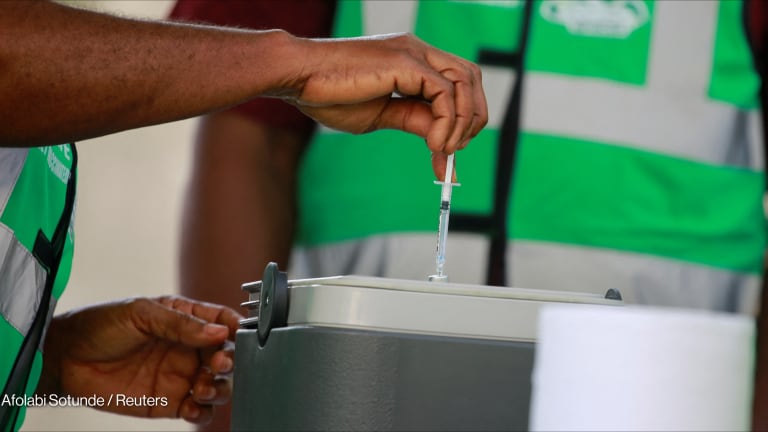
As the urgency and catastrophic impacts of the COVID-19 pandemic start to fade from the headlines, the movement to expand vaccine manufacturing in Africa has approached a critical moment. Expanding vaccines manufacturing on the continent emerged as a critical response to the delays that Africa faced in accessing COVID-19 vaccines. As a result, African stakeholders set out bold milestones of producing 10% of vaccines locally by 2025 and a long-term goal of producing 60% by 2040. But for these goals to be met, momentum and support cannot simply be maintained but needs to be drastically scaled up.
Pivoting to greater local production
As multiple efforts to expand vaccine manufacturing in Africa move forward, tipping the scales toward more sustainable vaccine production on the continent requires a rethink of biopharmaceutical manufacturing within well-established global health and investment frameworks and approaches.
Across the supply chain, key actions are needed to drive sustainable vaccine manufacturing forward in Africa, bring vaccines closer to patients, and promote equitable access. The following are three priority actions that can help ensure current efforts are sustainable in the long term.
1. De-risk investments in vaccine manufacturing
The Pro read:
De-risking health through blended finance
Agencies, financial institutions, and private firms are using blended finance to prove that health care companies are bankable.
Investments in vaccine manufacturing are inherently risky. De-risking investments to the extent possible is essential to mobilize resources from development banks, private equity investors, and other sources of capital required to make the sizable investments in expanding vaccine production.
The recent evaluation of the Access to COVID-19 Tools Accelerator, or ACT-A — the global collaboration to accelerate development, production, and equitable access to COVID-19 tests, treatments, and vaccines — recommended the establishment of an Advanced Commitment Facility that could help fund early research and development projects and facilitate purchasing commitments starting on “day zero” of the next pandemic. This type of capital will be essential for future pandemic responses. However, advanced market commitments need to be adopted more broadly outside of pandemic-specific responses. Even for countries that were able to make advanced purchases, a lack of manufacturing capacity was a major challenge during the rollout of COVID-19 vaccines.
Additional mechanisms for advanced market commitments as well as enabling trade and tax policies must be put in place during nonpandemic times to sustain and grow the manufacturing base. Without these supports, it is unlikely the sector will advance enough to have sufficient capacity to leverage during a future pandemic. Firm and transparent commitments from African governments, global and local procurement agencies, and donors will be essential in helping to shape sustainable markets that enable the sector to grow.
2. Integrate manufacturing into pandemic preparedness efforts
The ACT-A evaluators and many other stakeholders have flagged the importance of strengthening “regional manufacturing and health systems” as essential for future pandemic responses and pointed to the recently launched Financial Intermediary Fund for Pandemic Prevention, Preparedness and Response, now known as The Pandemic Fund, as a key mechanism for doing so. However, expanding regional manufacturing in Africa is not included in the fund’s current thematic priorities.
Strengthening and expanding manufacturing capacity should be part and parcel of health systems strengthening efforts and pandemic responses. Specific funding mechanisms, such as The Pandemic Fund, that aim to better equip health systems to respond to future pandemics must consider and invest in the development of sustainable regional biopharmaceutical manufacturing as part of these efforts.
3. Prioritize development of the enabling ecosystem
For vaccine manufacturing in Africa to be ready to respond to future pandemics and support routine vaccination during nonpandemic times, the focus must not be solely on supporting manufacturers themselves, but also on the enabling ecosystem required for the sector to succeed. One critical aspect is strengthening regulatory systems on the continent.
Increased investments in national and regional regulatory bodies as well as targeted support to operationalize the African Medicines Agency are essential and will help to foster assurance of the quality of vaccines produced and protect populations from poor-quality vaccines.
A key enabler also includes scaling up and maximizing continental-wide coordination mechanisms such as the Partnership for African Vaccine Manufacturing. Improved collaboration, information sharing, and a shared strategic vision not only help to make investments in vaccine manufacturing less risky, but can also assure that capacity built in one country or region complements rather than duplicates capacity in another region. This type of partnership and collaboration will require unprecedented levels of coordination between technical experts, politicians, and private-sector manufacturers and investors but will serve to foster sustainability of manufacturing across Africa.
Additionally, expanding research and development capabilities and strengthening the pharmaceutical workforce are critical to building a sustainable vaccine manufacturing ecosystem and must not be overlooked. National governments, working with technical partners and the World Health Organization, should expand and incentivize academic as well as on-the-job training programs while leaning on resource training hubs such as WHO’s messenger RNA hub, the African Pharmaceutical Technology Institute, and others to develop and retain technical skills and capacity.
The case for expanding vaccine manufacturing in Africa remains clear. But only through enhanced partnership, collaboration, and investment will we see the sector thriving in 2040.









